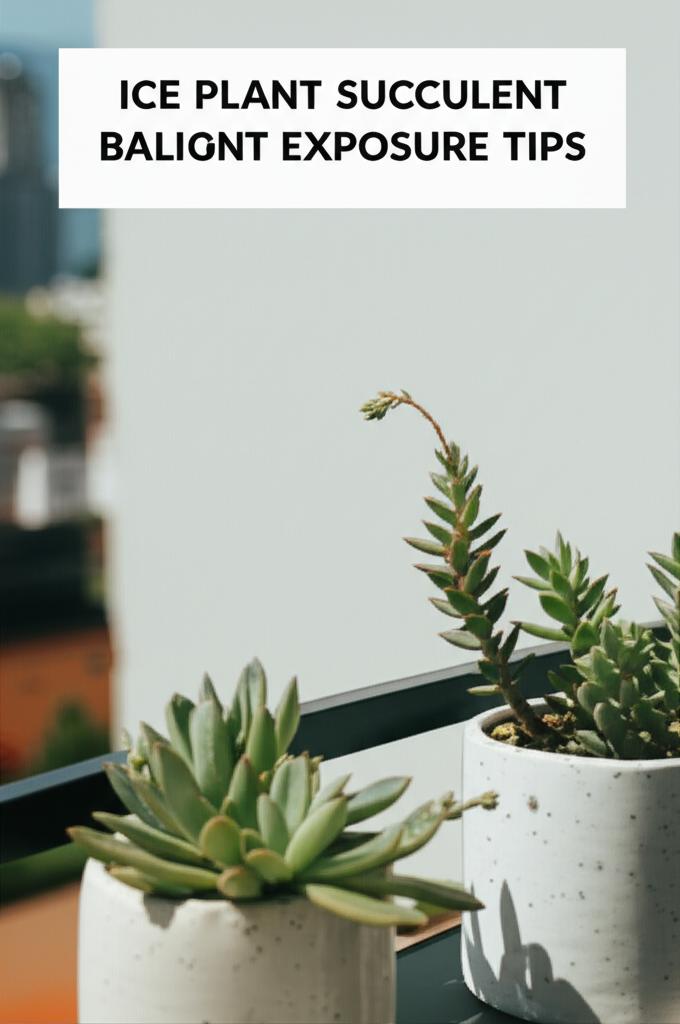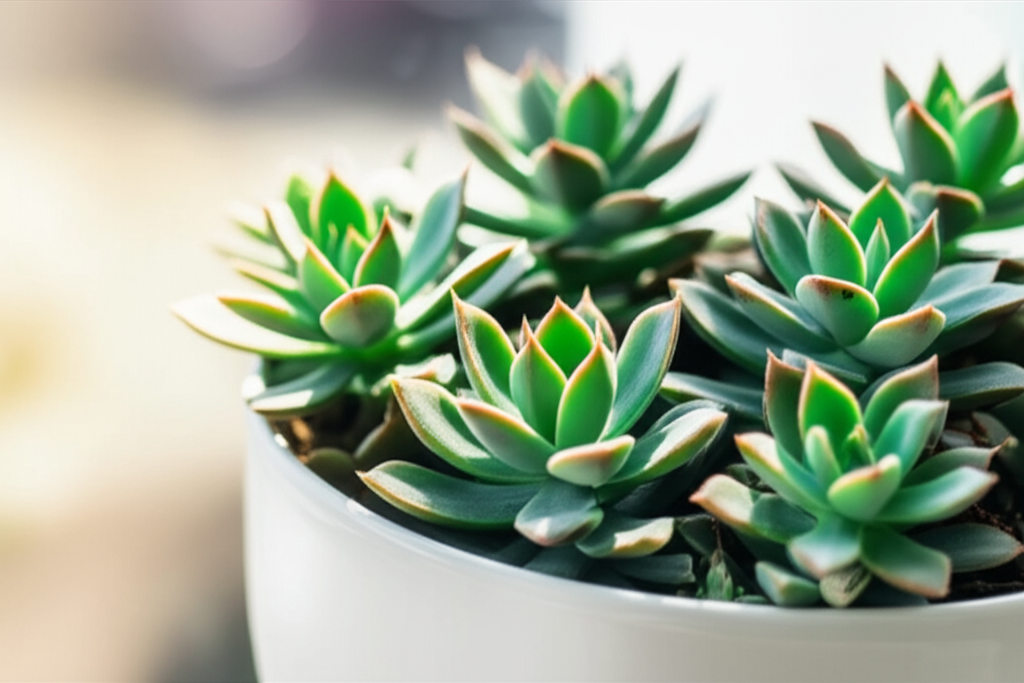Understanding Ice Plant Succulents and Their Sunlight Needs
Ice plants, scientifically known as members of the Aizoaceae family, are a diverse group of succulents renowned for their vibrant, jewel-like appearance and resilience. Their common name, “ice plant,” often refers to the tiny, water-filled vesicles (papillae) that cover their leaves and stems, giving them a glistening, dewy look, especially in the morning sun. These plants are native to arid and semi-arid regions, primarily in South Africa, where they have evolved to thrive in intense sunlight and tolerate periods of drought.
This natural adaptation to bright, direct sunlight is crucial for understanding how to best care for them, especially when cultivating them on a balcony. Balconies offer a unique microclimate, often providing more intense sunlight than a typical garden bed, but also presenting challenges like wind and fluctuating temperatures. For ice plants, the right amount of sunlight is not just beneficial; it’s essential for their health, flowering, and characteristic vibrant coloration.
Why Sunlight is Key for Ice Plants
Sunlight is the primary energy source for all plants, and ice plants are no exception. They utilize photosynthesis to convert light energy into chemical energy, fueling their growth, development, and reproductive processes.
- Photosynthesis: The process by which plants use sunlight, water, and carbon dioxide to create glucose (food) and oxygen. Adequate sunlight ensures efficient photosynthesis, leading to robust growth.
- Coloration: Many ice plant varieties exhibit intensified colors – reds, purples, and oranges – when exposed to ample sunlight. This is often a stress response that enhances their visual appeal.
- Flowering: Sufficient sunlight is a critical trigger for flowering in most ice plant species. Without enough light, they may produce fewer blooms or fail to flower altogether.
- Compact Growth: Insufficient light can lead to etiolation, where the plant stretches and becomes leggy as it seeks out more light. Proper sunlight promotes compact, bushy growth.
Assessing Your Balcony’s Sunlight Exposure

Before introducing ice plants to your balcony, it’s vital to accurately assess the amount of sunlight it receives throughout the day and across different seasons. This assessment will guide your placement decisions and help you choose the most suitable ice plant varieties.
Observing Sunlight Patterns
The best way to understand your balcony’s sunlight is through direct observation. Dedicate a few days to tracking how sunlight moves across your space.
- Morning Sun: Does your balcony receive direct sunlight in the early morning? This is typically a gentler form of light.
- Midday Sun: Is your balcony exposed to the intense, direct sun during the peak hours of the day (roughly 10 AM to 4 PM)?
- Afternoon Sun: Does the sun hit your balcony in the late afternoon, which can be quite warm in many climates?
- Shade Sources: Identify any structures, trees, or neighboring buildings that cast shade on your balcony at different times of the day.
Understanding Sunlight Intensity
Sunlight intensity varies based on geographical location, time of year, and whether it’s direct or filtered light.
- Direct Sunlight: Unobstructed sunlight that falls directly on the plant. This is what most ice plants crave, especially during cooler months.
- Filtered Sunlight: Sunlight that passes through a light screen, sheer curtain, or the leaves of a nearby tree. Some ice plants can tolerate this, particularly during the hottest parts of summer.
- Partial Shade: Areas that receive a few hours of direct sun per day, often in the morning or late afternoon.
Matching Ice Plant Varieties to Your Balcony’s Light Conditions
The Aizoaceae family is vast, and different species have slightly varying light requirements. Understanding these nuances will significantly improve your success.
High-Sun Varieties
These ice plants are best suited for balconies that receive at least 6-8 hours of direct sunlight daily, especially during the spring and fall.
- Delosperma (Hardy Ice Plants): Many varieties, like ‘Fire Spinner’ or ‘Sunrise’, thrive in full sun and are excellent for adding color.
- Lampranthus (Living Jewels): Known for their prolific, daisy-like flowers, these require ample sun to bloom profusely.
- Drosanthemum: With their distinctive, knobby papillae, these are classic ice plants that love bright, sunny locations.
Moderate-Sun Varieties
If your balcony gets about 4-6 hours of direct sunlight, or bright, indirect light for most of the day, these varieties might be a better fit.
- Conophytum: These small, pebble-like succulents often prefer slightly less intense midday sun, especially in very hot climates.
- Lithops (Living Stones): While they need bright light, the intense midday sun can sometimes scorch them. Partial shade during the hottest part of the day is beneficial.
Key Facts and Comparison of Ice Plant Sunlight Needs
Here’s a comparative look at how different types of ice plants generally fare with varying levels of sunlight exposure.
| Ice Plant Group | Ideal Sunlight Exposure | Tolerance to Intense Midday Sun | Flowering Potential | Coloration Intensity |
|---|---|---|---|---|
| Hardy Ice Plants (e.g., Delosperma) | 6-8+ hours direct sun | High | Excellent | High |
| Living Jewels (e.g., Lampranthus) | 6+ hours direct sun | Moderate to High | Excellent | High |
| Knick-knacked Ice Plants (e.g., Drosanthemum) | 6+ hours direct sun | Moderate | Good | High |
| Pebble Succulents (e.g., Conophytum) | 4-6 hours direct sun, bright indirect | Moderate (prefer shade from hottest midday sun) | Good (often smaller blooms) | Moderate to High |
| Living Stones (e.g., Lithops) | Bright light, 4-6 hours direct | Low to Moderate (prefer shade from hottest midday sun) | Good (when conditions are right) | High |
Optimizing Placement and Care for Balcony Ice Plants
Once you’ve assessed your balcony and chosen your ice plants, strategic placement and consistent care are paramount for their success.
Container Choice and Soil
The right container and soil mix are crucial for good drainage, which is vital for succulents to prevent root rot.
- Porous Pots: Terracotta or unglazed ceramic pots are ideal as they allow for better air circulation and faster drying of the soil compared to plastic.
- Drainage Holes: Ensure all pots have ample drainage holes at the bottom.
- Well-Draining Soil: Use a specialized cactus and succulent potting mix. You can also create your own by mixing potting soil with perlite or pumice (about a 2:1 ratio) to improve aeration and drainage.
Watering and Fertilizing
Watering is one of the most common challenges for succulent owners. Ice plants prefer a “soak and dry” method.
- Watering Frequency: Water thoroughly only when the soil has completely dried out. This might be once a week in hot, dry weather and much less often in cooler, humid conditions.
- Overwatering Signs: Yellowing, mushy leaves, or a generally sodden feel to the plant are signs of overwatering.
- Fertilizing: Ice plants are not heavy feeders. Feed them once or twice during the growing season (spring/summer) with a diluted, balanced liquid fertilizer (e.g., 10-10-10 or a specialized succulent fertilizer).
Protection from Extreme Conditions
Balconies can expose plants to harsh elements. Understanding how to protect your ice plants is key.
- Intense Summer Sun: If your balcony bakes in direct sun all day, especially during the hottest summer months, consider providing temporary shade for your more sensitive ice plant varieties. A sheer fabric shade cloth or moving them to a spot that gets morning sun but afternoon shade can be effective.
- Wind: Strong winds can dry out plants quickly and even damage delicate foliage. Grouping pots together or using windbreaks can help.
- Frost: Most ice plants are not frost-tolerant. Bring them indoors or provide protection if temperatures are expected to drop below freezing.
Troubleshooting Common Sunlight-Related Issues
Even with careful planning, you might encounter issues. Here are some common problems related to sunlight exposure and their solutions.
Etiolation (Stretching)
If your ice plant starts to grow long, thin stems with widely spaced leaves, it’s a clear sign it’s not receiving enough light.
- Cause: Insufficient sunlight.
- Solution: Gradually move the plant to a location that receives more direct sunlight. If the stretching is severe, you can prune the leggy stems; the cuttings can often be propagated to create new plants.
Sunburn (Scorching)
Pale, brown, or white patches on the leaves, often appearing after a period of intense sun, indicate sunburn.
- Cause: Sudden exposure to very intense sunlight, especially after being in lower light conditions, or prolonged exposure during the hottest part of the day without acclimatization.
- Solution: Move the plant to a location with less intense sun, or provide filtered shade during the hottest hours. Damaged leaves won’t recover but should be trimmed off to prevent disease. New growth should be healthier.
Lack of Flowering
If your ice plants are healthy but not blooming, sunlight is often the culprit.
- Cause: Insufficient sunlight.
- Solution: Ensure the plants are receiving at least 6-8 hours of direct sunlight daily. Adjust their position on the balcony to maximize sun exposure.
Steps to Optimize Balcony Ice Plant Sunlight Exposure
Here’s a step-by-step approach to ensure your ice plants get the right amount of sunlight.
| Step | Action | Pros | Cons |
|---|---|---|---|
| 1 | Observe Balcony Sunlight | Identifies optimal locations and potential shade issues. | Time-consuming; requires consistent monitoring. |
| 2 | Select Appropriate Varieties | Matches plant needs to balcony conditions. | Requires research into different ice plant species. |
| 3 | Choose Porous Containers with Drainage | Prevents root rot, promotes healthy growth. | Can dry out faster, requiring more frequent watering checks. |
| 4 | Use Well-Draining Soil Mix | Ensures efficient water drainage. | May require purchasing or mixing specific components. |
| 5 | Position Plants Strategically | Maximizes sunlight for high-sun varieties, protects others. | Requires moving pots as seasons or sun angles change. |
| 6 | Acclimatize New Plants | Prevents sunburn from sudden light changes. | Requires a gradual transition period. |
| 7 | Monitor for Sunburn or Etiolation | Allows for timely intervention to correct issues. | Requires regular plant inspection. |
| 8 | Provide Seasonal Protection | Protects plants from extreme heat, cold, or wind. | May involve bringing plants indoors or using additional materials. |
Seasonal Adjustments for Balcony Sunlight
The sun’s angle and intensity change significantly throughout the year. Adapting your ice plants’ placement accordingly will ensure they continue to thrive.
Spring
As temperatures rise and days lengthen, your ice plants will begin their active growing season. Most varieties will appreciate the increasing sunlight.
- Placement: Gradually move plants to brighter locations if they were overwintered indoors or in shadier spots.
- Watering: Increase watering frequency as the weather warms, but always check soil moisture first.
Summer
Summer can be a double-edged sword. While ice plants love sun, the intense midday heat and prolonged exposure can be detrimental to some species.
- Placement: For balconies with relentless, direct sun, provide afternoon shade for sensitive varieties. Morning sun and early afternoon sun are generally ideal.
- Watering: Monitor soil moisture closely. Water deeply when dry, and be mindful of extreme heat which can dry soil rapidly.
Autumn
Autumn is a glorious time for many ice plants, with cooler temperatures and often a resurgence in flowering.
- Placement: Maximize sunlight exposure as temperatures become more moderate.
- Watering: Reduce watering frequency as growth slows down and temperatures cool.
Winter
Many ice plants go dormant or semi-dormant during winter. Their light needs may decrease, but bright, indirect light is still beneficial.
- Placement: If bringing plants indoors, place them in the brightest window available. If kept outdoors in a milder climate, ensure they are protected from frost and receive as much light as possible.
- Watering: Water very sparingly, only enough to prevent the roots from completely drying out.
By carefully considering your balcony’s unique light conditions and adapting your care routine throughout the seasons, you can cultivate a vibrant and thriving collection of ice plant succulents, transforming your balcony into a dazzling succulent oasis.


